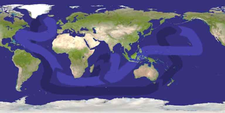Oceanography
2007 Schools Wikipedia Selection. Related subjects: Geology and geophysics
Oceanography (from Ocean + Greek γράφειν = write), also called oceanology or marine science is the branch of physical geography that studies the Earth's oceans and seas. Oceanographers study a wide range of topics such as plate tectonics to ocean currents to marine organisms. These diverse topics reflect multiple disciplines that oceanographers blend to help us understand Earth's interdependencies: biology, chemistry, geology, meteorology, and physics.
Branches
The study of oceanography has four main branches:
Marine biology or biological oceanography
the study of the plants and animals ( biota) of the oceans and their ecological interaction.
Chemical oceanography
the study of the chemistry of the ocean;
Marine geology or geological oceanography
the study of the geology of the ocean floor including plate tectonics; and
Physical oceanography
studies the ocean's physical attributes including temperature-salinity structure, waves, tides and currents).
Metorological oceanography
studies the ocean-atmosphere interactions
These branches reflect the fact that many oceanographers are first trained in the exact sciences and then focus on applying their interdisciplinary knowledge, skills and abilities to oceanography.
History
Early exploration of the oceans was limited to its surfaces and the few creatures that fishermen brought up in nets, but when Bougainville and Cook carried out their explorations in the South Pacific, the seas themselves formed part of the reports.
James Rennell wrote the first scientific textbooks about currents in the Atlantic and Indian oceans during the late 18th and at the beginning of 19th century. Sir James Clark Ross took the first modern sounding in deep sea in 1840, and Charles Darwin published a paper on reefs and the formation of atolls.
The steep slope beyond the continental shelves was not discovered until 1849. Matthew Fontaine Maury's Physical Geography of the Sea, 1855 was the first textbook of oceanography. The first successful laying of Transatlantic telegraph cable in August 1858 confirmed the presence of an underwater "telegraphic plateau" mid-ocean ridge.
After the middle of the 19th century, scientific societies were processing a flood of new terrestrial botanical and zoological information. European natural historians began to sense the lack of more than anecdotal knowledge of the oceans.
Oceanography began as a quantifiable science in 1872, when the Scots Charles Wyville Thompson and Sir John Murray launched the Challenger expedition (1872–1876). Other European and American nations also sent out scientific expeditions (as did private individuals and institutions). The four-month 1910 North Atlantic expedition headed by Sir John Murray and Johan Hjort was at that time the most ambitious research oceanographic and marine zoological project ever, and led to the classic 1912 book The Depths of the Ocean.
Oceanographic institutes dedicated to the study of oceanography were founded. In the United States, these included the Scripps Institution of Oceanography, Woods Hole Oceanographic Institution, Lamont-Doherty Earth Observatory at Columbia University, and the School of Oceanography at University of Washington. In Britain, there is a major research institution: National Oceanography Centre, Southampton. In Australia, CSIRO Marine and Atmospheric Research, known as CMAR, is a leading centre.
The first international organization of oceanography was created in 1902 as the International Council for the Exploration of the Sea.
In 1921 Monaco formed the International Hydrographic Bureau (IHB). Then in 1966, the U.S. Congress created a National Council for Marine Resources and Engineering Development. NOAA was in charge of exploring and studying all aspects of Oceanography. It also enabled the National Science Foundation to award Sea Grant College funding to multi-disciplinary researchers in the field of oceanography.
Ocean and atmosphere connections
The study of the oceans is intimately linked to understanding global warming and related biosphere concerns.
| Our planet is invested with two great oceans; one visible, the other invisible; one underfoot, the other overhead; one entirely envelopes it, the other covers about two thirds of its surface. | ||
|
— Matthew F. Maury (1855) The Physical Geography of the Seas and Its Meteorology
|
Notable oceanographers
- Robert Ballard ( ONR Science Explorer)
- VADM W. W. Behrens, Jr. ( NOAA - Futurist)
- Henry Bryant Bigelow
- RADM Richard E. Byrd
- M. Ilham Artuz HAE
- Jacques Cousteau
- Robert S. Dietz
- V. Walfrid Ekman
- Evan Forde
- Gotthilf Hempel
- Johan Hjort
- RADM Grace Murray Hopper USNR - Futurist
- Charles David Keeling
- Uwe Kils
- Matthew Fontaine Maury ( US Naval Observatory)
- CAPT Homer A. McCrerey ( FNMOC - Futurist)
- Walter Munk
- Sir John Murray
- Tad Murty
- Stefan Rahmstorf
- Johan Sandström
- Yuly Shokalsky
- RADM Charles Dwight Sigsbee ( Hydographer)
- Henry Stommel
- Harald Sverdrup
- Mary Sears
- CAPT Don Walsh ( Challenger Deep - Deep sea explorer)
- Warren White
- Osman El-Rayis
- Charles Wilkes ( United States Exploring Expedition)

